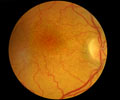- An imitation of the human blood-retinal barrier has been developed successfully.
- It may reduce the use of animals for animal testing.
- It is made from a co-culturing of human cells.
José Yeste, the main author of the study, explains that the device is composed of several parallel compartments, arranged to emulate the retinal layer structure. In every compartment, a type of cells has been cultured: endothelial cells (which constitute capillary vessels which carry oxygen and nutrients), neuronal cells (which form the neuroretina), and retinal pigmented epithelial cells, which form the outer layer of the blood-retinal barrier.
The compartments are interconnected by a grid of microgrooves under the cells, with which cells can exchange signal molecules and therefore communicate between them.
Substances produced by some cells can reach the other cells, generating a cellular communication and interaction like in a living organ. Also, the device enables to expose endothelial cells to the particular mechanical conditions, like the ones induced by the blood stream.
As Rosa Villa, a CSIC scientist and leader of the Biomedical Applications Group, explains, "in the living organism, endothelial cells that cover the inner walls of blood vessels are exposed to the mechanical stimulus of the blood stream. In the cell cultures where this condition is not reproduced, we could say the cells are like "sleepy" and do not react as they would do in real conditions".
Rafael Simó, who leads the Diabetes and Metabolism group of the Vall d'Hebron Research Institute (VHIR) says: "The most relevant characteristic of this technology is that mimics what happens 'in vivo' in the retina and therefore can be an essential tool to boost the in vitro experimentation.
The scientists tested the correct formation of the blood-retinal barrier assessing its permeability, its electrical resistance and the expression of some proteins of the tight junctions between cells, which are expressed when cells have established a barrier function.
The tests have been designed to check whether the barrier was properly formed, but keeping the natural permeability to allow the pass of nutrients and oxygen, and to find out if the cells were in contact and interacting.
This device, scientists say, can be used to study the effects of molecules or harming conditions on the human retina. The team also wants to use the device to study the diabetic retinopathy, a disease whose causes and progression are not well understood yet.
References:
- Jose Yeste, Marta García-Ramírez et al. A Compartmentalized Microfluidic Chip with Crisscross Microgrooves and Electrophysiological Electrodes for Modeling the Blood–retinal Barrier, Lab on a Chip DOI: 10.1039/C7LC00795G
Source-Eurekalert










